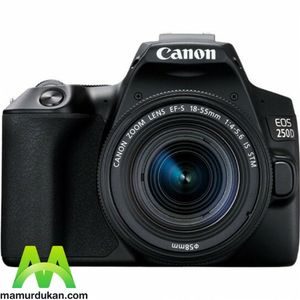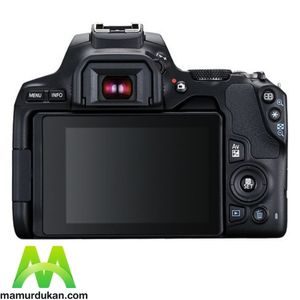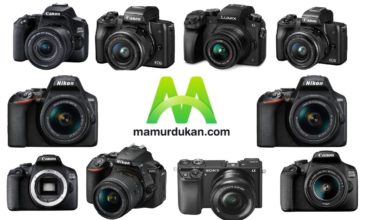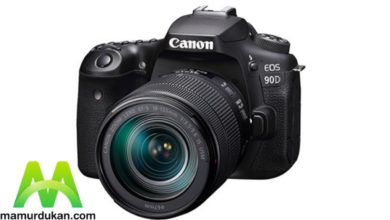| Price | 58500 BDT |
Canon EOS 250D Specs:
Image Sensor
| Type | IMAGE SENSOR |
| Pixels | Effective Pixels: Approx. 24.10 megapixels Total Pixels: Approx. 25.80 megapixels |
| Aspect Ratio | 3:2 |
Focusing
| Af Point | 9 |
| Modes | AI Focus, One Shot, AI Servo (AI Servo II algorithm) |
Exposure Control
| Metering Modes | Via optical viewfinder: 63-zone dual-layer metering sensor with Evaluative, partial, spot (center only), and center-weighted average available Via LiveView on LCD screen: 1. Evaluative metering (384 zones) 2. Partial metering (approx. 5.5 % of the LCD screen) 3. Spot metering (approx. 3.7 % of the LCD screen) 4. Center-weighted average metering |
| ISO Sensitivity | Auto (100-25600), 100-25600 (in whole stop increments) ISO can be expanded to H: 51200 During Movie shooting: Auto (100-12800), 100-12800 (in 1/3-stop or whole stop increments) ISO can be expanded to H: 25600. 4K Movie Max. 6400 |
Shutter
| Shutter Speed | 30-1/4000 sec (1/2 or 1/3 stop increments), Bulb (Total shutter speed range. Available range varies by shooting mode) |
Shooting
| Color Space | sRGB and Adobe RGB |
| Continuous Shooting | Max. Approx. 5 fps. |
File Type
| Image Type | JPEG: Fine, Normal (Exif 2.31 [Exif Print] compliant) / Design rule for Camera File system (2.0) RAW: 14bit, Canon original RAW 3rd edition Digital Print Order Format [DPOF] Version 1.1 compliant |
| Image Size | JPEG 3:2: (L) 6000 x 4000, (M) 3984 x 2656, (S1) 2976 x 1984, (S2) 2400×1600, JPEG 4:3: (L) 5328×4000, (M) 3552×2664, (S1) 2656×1992, (S2) 2112×1600, JPEG 16:9: (L) 6000×3368, (M) 3984×2240, (S1) 2976×1680, (S2) 2400×1344, JPEG 1:1: (L) 4000×4000, (M) 2656×2656, (S1) 1984×1984, (S2) 1600×1600, RAW: (RAW) 6000×4000 |
| Movie Type | MP4 (Video: H.264 inter frame, Sound: Linear PCM / AAC, recording level can be manually adjusted by user) MOV (Video: H.264 All-I Full HD, no sound) – time-lapse movie only |
| Movie Size | 3840 x 2160 (23.98, 25 fps) inter-frame 1920 x 1080 (59.94, 50 fps) inter-frame 1920 x 1080 (29.97, 25 fps) inter-frame 1920 x 1080 (29.97, 25) lite inter-frame 1280 x 720 (59.94, 50 fps) inter-frame |
LCD Monitor
| Type | Vari-angle touchscreen 7.7 cm (3.0″) 3:2 Clear View II TFT, approx. 1040 K sRGB dots |
| Viewing Angle | Approx. 170° |
Storage
| Storage Type | SD, SDHC, SDXC (UHS Speed Class 1 compatible) |
| Built-in Flash | Yes |
| Red-Eye Reduction | Yes |
Power Source
| Batteries | Rechargeable Li-ion Battery LP-E17 |
Physical Specification
| Dimensions (W x H x D) | 122.4 x 92.6 x 69.8mm |
| Weight (Body Only) | 449g |
Lens
| Lens Mount | EF mount |
| Focal Length | Approx. 1.6x the focal length of the lens |
Manufacturer Warranty
| Warranty | 03 Years Service Warranty ( No Parts Warranty) |
Canon EOS 250D price in Bangladesh
Canon EOS 250D price in Bangladesh is BDT 58,5000 Taka. The Canon EOS 250D isn’t Canon’s cheapest DSLR, but it’s the cheapest we would recommend buying. The Canon DSLR range seems to be going across a phase of connection rather than technological advancements, which is a polite way of saying that it hasn’t done anything especially new for a while. The new EOS 250D fits in that order, with Canon using technologies we have formerly seen in other Canon cameras to refresh the being EOS EOS 200D.

Body Viewfinder And Screen of Canon EOS 250D
The EOS 250D is veritably small for a DSLR, especially in range and weight. The DSLR design means the body has to be thicker to accommodate the glass, and while the Canon 18-55 mm f/ 4-5.6 IS STM tackle lens is enough compact, it’s not a renouncing type, so the combination of the thick camera body and lens makes the Canon a lot longer than rival mirrorless cameras like the Fujifilm X-T200. It’s clearly compact for a DSLR, but it’s a good deal bigger than a mirrorless model, especially if you weigh it up against Micro Four Thirds rivals from Olympus and Panasonic. The body has a good-sized grip, making the Canon easy and secure to hold one-handed. The body does have a slightly plasticky sense, but that is neutralized by high-quality clods and dials – especially the main mode dial and power on/ off switch, which has a third position for entering the videotape mode. The viewfinder is a little lower than average for a DSLR because it uses a cheaper ‘pentamirror’ design rather than the usual pentaprism, but it’s bright and sharp, and the autofocus points and shooting information show up easily. The colorful-angle screen on the reverse is excellent. You switch to Live View by pressing a button on the reverse of the camera and you can also use the touch control to set the focus point and change camera settings. It’s sharp, various, and clear and the touch response is first-rate. Piecemeal from the mechanical noise when the glass is flipped up to enter Live View mode, this is just like using a mirrorless camera, as the autofocus response is just as rapid-fire. It’s intriguing that while numerous people are opining on how mirrorless cameras are getting better than DSLRs, Canon has designed a DSLR to match mirrorless cameras for the very thing they are designed to do stylish – live view photography. You can flip the hinder screen out to use it at any angle, fold it back against the camera facing outwards to show settings and image information, or fold it so that it’s facing inwards for protection, and just use the viewfinder to compose and shoot your filmland.

Menu & Operation of Canon EOS 250D
Some of the minor buttons feel a little small and the hinder four-way control pad is clearly on the small side, squashed in between the TV display and the edge of the camera. Still, given the Revolutionary EOS 250D’s small size, Canon has done a great job of chancing space for its external controls while still giving them room to breathe. It’s a bit annoying that you have to open the battery door on the base of the camera to get to the memory card niche rather than having a separate door in the side of the camera, but this is common in cameras in this price type, and it’s only an issue if you want to change memory cards while the camera is on a tripod.

Image Quality of Canon EOS 250D
The standard 18-55 mm kit lens we were handed equally with our Canon EOS 250D DSLR is impeccably acceptable for newcomers getting started out of the box, and image quality is decent, with detail being maintained into the corners of the frame. More demanding druggies will, still, want to upgrade it to a high lens or two, rather than a drone, to get indeed sharper results than this jack-of-all-trades option provides. This being a Canon DSLR, still, colors and discrepancy straight out of the camera ensure that images pop, without being exorbitantly impregnated. Meat tones look warm, while flora, blues, and reds are rendered vividly. In short, this is a camera with which you can point and shoot and won’t need to do too important to the images, piecemeal from occasional stropping or discrepancy adaptation if seeking lesser depth or description.

Dynamic Range of Canon EOS 250D
The EOS 250D is able of veritably similar dynamic range to its 24MP APS-C Canon DSLR stablemates at lower ISO perceptivity, but that new DIGIC 8 processor has hardly bettered dynamic range at ISO 800 and over. It’s still not enough to eclipse the FujilfilmX-T100, let alone the potent Olympus-M10 III, but the EOS 250D easily beats its main DSLR rival from Nikon.
Noice of Canon EOS 250D
This test measures the clarity of images at each of the camera’s ISO perception settings – the less noise/ grain in an image, the better the score. The EOS 250D does well then, producing the cleanest images of the group at lower perceptivity, and only running the Olympus-M10 III by a small periphery at ISO 3200 and over. Though the EOS 250D likely uses the same detector as in the 200D, as well as aged cameras like the 800D, the new DIGIC 8 processor in the 250D has bettered the camera’s signal-to-noise performance, as it scores around 5% better than the 200D at each perceptivity setting.

Video Quality of Canon EOS 250D
The EOS 250D supports a 4K videotape captured, but as with the EOS M50, it comes with caveats. There is a heavy crop applied when rolling 4K, the frame rate is locked at23.98 fps, and the Dual Pixel AF system does not work. Rather, autofocus is contrast-grounded, just like any other SLR videotape system. Dropping the resolution to 1080p enables Binary Pixel focus and opens up the frame, using the full range of the detector for prisoners. Curiously there is no option for 24 fps; rather, you can choose from 60 fps (59.94 p), or two situations of 30 fps (29.97 p) quality. You can drop to 720p and record at 60 fps only. Vloggers can see the appeal of the EOS 250D. It’s small, has a front-facing screen, and can take an external microphone. It does not offer in-body image stabilization, a plus for keeping wide-angle videotape steady, but there are affordable stabilized lenses for the Canon system, including the, whisked 18-55 mm and, if you want wider content, the EF-S 10-18 mm f/4.5-5.6 IS STM is also a solid choice. But you will have to live with the EOS 250D’s limitations. That means a heavy crop at 4K, a lack of a 24 fps option at 1080p, and a lack of further advanced options like a flat profile or deputy recording. However, you will not miss them, If you do not know what those are. But if you do, you may find them important for your workflow.
Canon EOS 250D Autofocus
The EOS 250D powers on focuses and captures an image in about a half-alternate, with a great speed to snare a candid shot. In bright light the focus is veritably quick to lock onto a static subject, doing so and landing a print in lower than0.05-second. In veritably dim light the focus time extends, taking about0.3-second to nab focus with the tackle lens, which is par for the course for an entry-position SLR. Keeping moving subjects in crisp focus is another matter. It’s an area where the SL3 does not keep up with the slightly larger Revolutionary T7i. The EOS 250D’s autofocus system is veritably introductory, with nine selectable points, grouped covering roughly a third of the detector area.
Pros & Cons of Canon EOS 250D
Pros
- Compact.
- Vari-angle touch LCD.
- 1080p video with good autofocus.
- External mic support.
- Wi-Fi and Bluetooth.
Cons
- 4K video shows heavy crop and choppy focus.
- Autofocus struggles with action.
- Not as capable as mirrorless alternatives.
If you are interested to watch some latest laptops which are available on the market, please check this out. Latest laptops in Bangladesh Also if you want to see the latest smartphones, please check these out!!! Smartphones Our information may not be 100% accurate. To clarify, you can visit their official site Canon
58,500 Taka
Pros
Compact. Vari-angle touch LCD. 1080p video with good autofocus. External mic support. Wi-Fi and Bluetooth.
Cons
4K video shows heavy crop and choppy focus. Autofocus struggles with action. Not as capable as mirrorless alternatives.
3 Years
The Canon EOS 250D is an impeccably pleasing camera to use, with good running, operation as anticipated, and nice image quality, and the responsive touchscreen, fast launch-up time, and excellent Binary Pixel CMOS AF system all help to make it a veritably able each- rounder. The new processing machine may not deliver anything redundant in terms of burst rate over the former EOS 200D, but it does at least bring the camera’s videotape functionality close to the current standard. It’s also potentially responsible for the camera’s emotional battery life; being suitable to use the camera casually for many days without the battery dropping a single bar is kindly unusual, but utmost hello. Still, with the same detector as ahead, and no changes to either the viewfinder or TV screen, it’s not the most significant update. 4K videotape is subject to limitations, and having just one cross-type point in the meager nine-point array is rather niggardly in 2019.


